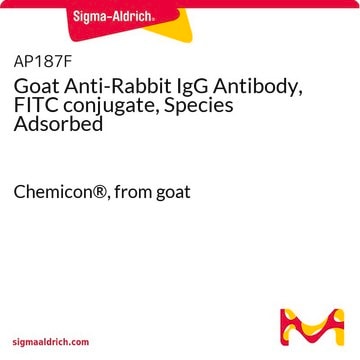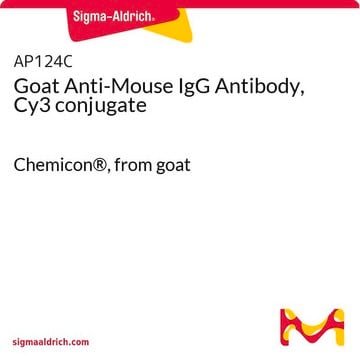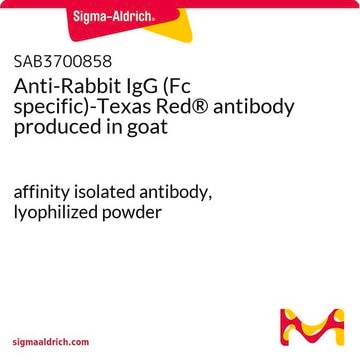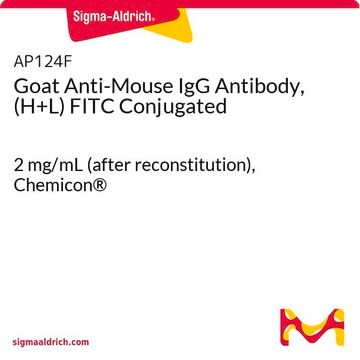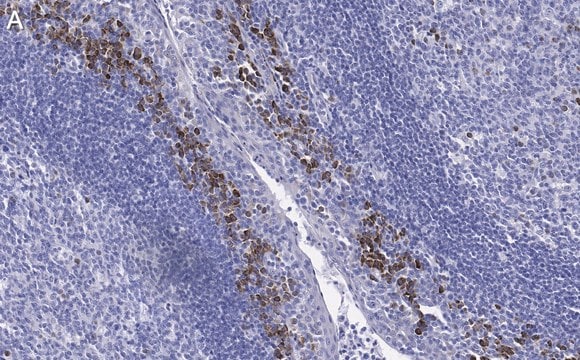AP106F
Rabbit Anti-Goat IgG Antibody, FITC conjugate
Chemicon®, from rabbit
Zaloguj sięWyświetlanie cen organizacyjnych i kontraktowych
About This Item
Kod UNSPSC:
12352203
eCl@ss:
32160702
NACRES:
NA.46
Polecane produkty
pochodzenie biologiczne
rabbit
Poziom jakości
białko sprzężone
FITC conjugate
forma przeciwciała
F(ab′)2 fragment of affinity isolated antibody
rodzaj przeciwciała
secondary antibodies
klon
polyclonal
reaktywność gatunkowa
goat
producent / nazwa handlowa
Chemicon®
metody
immunofluorescence: suitable
Warunki transportu
wet ice
docelowa modyfikacja potranslacyjna
unmodified
Powiązane kategorie
Specyficzność
Goat IgG (H&L)
FLUOROPHORE/PROTEIN:
Approximately 7.2 mg/mg; 2.7 moles FITC per mol IgG
FLUOROPHORE/PROTEIN:
Approximately 7.2 mg/mg; 2.7 moles FITC per mol IgG
Immunogen
Purified Goat IgG.
Zastosowanie
DILUTION:
Suggested dilution for most applications: 1:50-1:200
Optimal working dilutions must be determined by the end user.
Suggested dilution for most applications: 1:50-1:200
Optimal working dilutions must be determined by the end user.
Detect Goat IgG using this Rabbit anti-Goat IgG Antibody, FITC conjugate validated for use in IF.
Postać fizyczna
Liquid in 0.01 M Phosphate buffer, 0.25 M NaCl pH 7.6 with 15 mg/mL BSA, 0.01% Thimerosal and 0.05% sodium azide.
RECONSTITUTION:
Reconstitute to 1 mg/mL with sterile distilled water.
RECONSTITUTION:
Reconstitute to 1 mg/mL with sterile distilled water.
Przechowywanie i stabilność
Maintain lyophilized product between 2 and 8°C for up to 12 months. After reconstitution the product is stable for several weeks at 2-8°C as an undiluted liquid. For extended storage after reconstitution, add an equal volume of glycerol to make a final concentration of 50% glycerol followed by storage at -20°C in undiluted aliquots for up to 12 months. Please note the concentration of protein (and buffer salts) will decrease to one-half of the original after the addition of glycerol. Avoid repeated freeze/thaw cycles.
Informacje prawne
CHEMICON is a registered trademark of Merck KGaA, Darmstadt, Germany
Ta strona może zawierać tekst przetłumaczony maszynowo.
Nie możesz znaleźć właściwego produktu?
Wypróbuj nasz Narzędzie selektora produktów.
Zwroty wskazujące rodzaj zagrożenia
Zwroty wskazujące środki ostrożności
Klasyfikacja zagrożeń
Aquatic Chronic 3
Zagrożenia dodatkowe
Kod klasy składowania
11 - Combustible Solids
Klasa zagrożenia wodnego (WGK)
WGK 3
Certyfikaty analizy (CoA)
Poszukaj Certyfikaty analizy (CoA), wpisując numer partii/serii produktów. Numery serii i partii można znaleźć na etykiecie produktu po słowach „seria” lub „partia”.
Masz już ten produkt?
Dokumenty związane z niedawno zakupionymi produktami zostały zamieszczone w Bibliotece dokumentów.
Hui Shi et al.
Folia histochemica et cytobiologica, 56(3), 141-150 (2018-09-07)
High levels of reactive oxygen species (ROS) have potential toxic effects on testicular function and sperm quality. Peroxiredoxins (PRDXs) are enzymes with a role as ROS scavenger. The aim of the study was to reveal the presence and localization of
Efficient In Vivo Delivery of siRNA Into Brain Capillary Endothelial Cells Along With Endogenous Lipoprotein.
Kuwahara H, Nishina K, Yoshida K, Nishina T, Yamamoto M, Saito Y, Piao W, Yoshida M et al.
Molecular Therapy null
Rineke de Jong et al.
Nature communications, 13(1), 6142-6142 (2022-10-18)
Respiratory syncytial virus (RSV) infection causes a substantial lower-respiratory-tract disease burden in infants, constituting a global priority for vaccine development. We evaluated immunogenicity, safety and efficacy of a chimpanzee adenovirus (ChAd)-based vaccine candidate, ChAd155-RSV, in a bovine RSV (bRSV) challenge
Taoran Chen et al.
Vaccines, 11(8) (2023-08-26)
H7N9 avian influenza virus (AIV) has caused huge losses in the poultry industry and impacted human public health security, and still poses a potential threat. Currently, immune prevention and control of avian influenza relies on traditional inactivated vaccines; however, they
Juhui Qiao et al.
Molecular medicine reports, 25(6) (2022-05-12)
The aim of the present study was to examine the neuroprotective effects of a panel of active components of ginseng and to explore their molecular mechanisms of action in two rotenone (Rot)‑induced models of Parkinson's disease: An in vitro model using
Nasz zespół naukowców ma doświadczenie we wszystkich obszarach badań, w tym w naukach przyrodniczych, materiałoznawstwie, syntezie chemicznej, chromatografii, analityce i wielu innych dziedzinach.
Skontaktuj się z zespołem ds. pomocy technicznej



